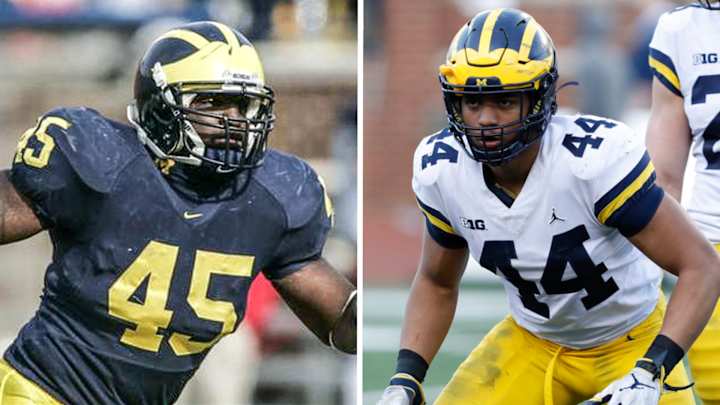Michigan Player Comparison: Cam McGrone Could Finish As One Of U-M's Great Linebackers

Redshirt sophomore inside linebacker Cam McGrone recorded just one stop and a quarterback hurry in his first-career collegiate start, a 52-0 Michigan win over lowly Rutgers. Despite the sparse statline while filling in for injured starter Josh Ross, head coach Jim Harbaugh saw enough to foreshadow what would become a revelatory season for the Indianapolis native.
“Cam McGrone, if he keeps playing like this, he’s going to be a star,” Harbaugh said following the game on McGrone.
As the season progressed, the flashes of potential that led to Harbaugh’s bold statement grew in frequency, with McGrone never relinquishing his starting spot and his presence in the middle of the U-M defense earning him honorable mention All-Big Ten honors.
A composite four-star recruit who earned five-star status by some recruiting services, McGrone spent much of his first year on campus on the sideline watching then-starter and current Pittsburgh Steeler Devin Bush dominate opposing offenses with speed and athleticism rarely found at the middle linebacker position. Although McGrone possesses exceptional athleticism in his own right, his larger frame lends a closer to comparison to another former Wolverine star—former middle linebacker and 11-year NFL veteran David Harris.
At 6-foot-1, 232 pounds, McGrone is an inch shorter and seven pounds lighter than Harris was during his fifth-year senior campaign, but he does have time and the build to add comparable mass. Overall, Harris boasted a more powerful physique, as proven by his 250-pound professional playing weight, but McGrone holds the advantage in straight-line speed over Harris, who ran a 4.59 40-yard dash at the 2007 NFL Combine.
Because he was so proficient at other aspects of the game, particularly in stuffing the run, Harris’s athleticism was at times overlooked. He played with great lateral quickness and football speed, in part due to his ability to quickly and correctly recognize and react to plays, that exceeded his combine numbers. McGrone has more raw athleticism than Harris had but, although his read-and-react ability is advanced for player at this stage in his career, isn’t quite at Harris’ football IQ level yet. He also moves very well laterally with a quick burst and ability to change direction that allows him to shoot through gaps on the offensive line, characteristics that made Harris an effective blitzer in the collegiate game and led to 22.0 tackles for loss in his last two seasons donning the Maize and Blue.
Harris was elite at shedding blocks and better at the point of contact against offensive linemen than McGrone is at this point in his career, but McGrone has the potential to be better in coverage given his athletic tools. Still, Harris was by no means a liability defending the pass. Like Harris, McGrone is solid tackler and he showed signs of being tough, physical player akin to Harris at times this season—but they key will be consistency.
In fact, consistency is the biggest separator between Harris and McGrone at this point. By the time Harris was a fifth-year senior, he was a model of reliability for the Wolverines—a leader by example who mastered the intricacies of the position en route to becoming a second-round pick in the 2007 NFL Draft. For McGrone to take the next step in 2020 and fulfill his All-Conference and even All-American potential, he has to find this same level of habit—he recorded three or fewer tackles in four of 10 starts on the season, and there were some coverage and assignment missteps to mitigate moving forward.
Entering his redshirt sophomore season, Harris was in the midst of recovering from a knee injury suffered as a freshman—a process that took the better part of two years—and had registered just two tackles in two games played. McGrone finished his redshirt freshman campaign with 66 tackles, including 9.5 for loss, four sacks, a forced fumble and one pass deflection. Harris didn’t truly emerge until his junior year, when he recorded 88 tackles, including six for loss, two forced fumbles and a fumble recovery. During his fifth-year senior campaign, in which he earned All-Big Ten and team Co-MVP honors, he stockpiled 103 stops, including 16 for loss and four sacks, intercepted a pass, deflected two passes and forced a fumble for a U-M defense that was among the best in the nation. His final statline at Michigan included 193 tackles, 22.0 of which came in the opposing backfields, 4.5 sacks, three forced fumbles, an interception and one fumble recovery.
A year ahead in terms of experience and with the physical tools he possesses, McGrone has the opportunity to be a star, as Harbaugh put it, and put up comparable numbers as Harris if he can continue to build off of his stellar first season as a starter and channel the habits of the former Wolverine great.
What do you think of the comparison? How good can McGrone be? Comment below!!!
